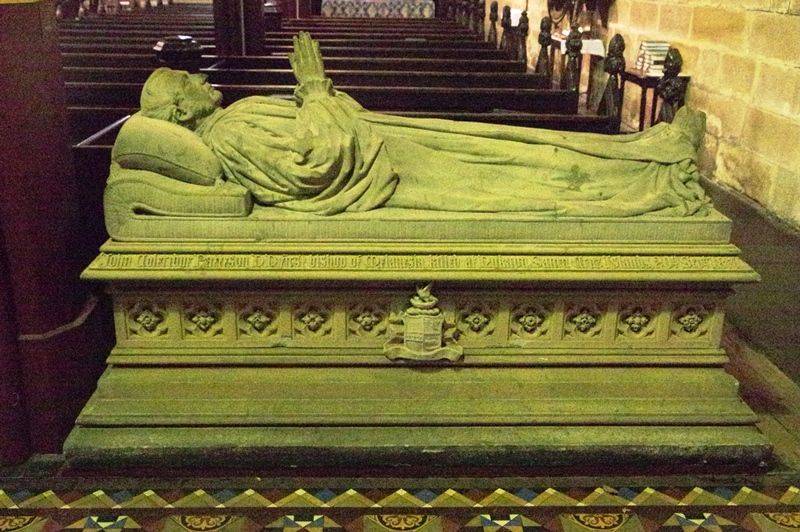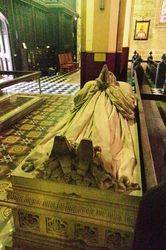
John Coleridge PattesonPrint Page 
The sculptured cenotaph commemorates John Coleridge Patteson, first Bishop of Melanesia who was killed at Santa Cruz Islands in 1871.
In March 1855, Patteson sailed in the Duke of Portland and arrived at Auckland in July. For five years he sailed in the schooner Southern Cross on annual cruises among the islands and ran the mission's summer school at Kohimarama, Auckland. On 24 February 1861 at Auckland he was consecrated first bishop of Melanesia. A brilliant linguist, he later spoke twenty-three of the many Melanesian languages: finding them in groups, he printed grammars and vocabularies and translated some gospels into the Mota dialect. Each year he spent some months on Mota in the New Hebrides.
In March 1864 Patteson visited Australia. In Sydney he addressed a large meeting which pledged systematic support of the Melanesian Mission; the Anglican Churches agreed to meet the annual expenses of the Southern Cross. In 1865 the governor of New South Wales, Sir John Young offered him a grant on Norfolk Island for his headquarters. In 1867 the Melanesian Mission moved to Norfolk Island where it was called St Barnabas..
The visits to the islands were becoming yearly more dangerous. In 1869 he noted the depopulation of many islands and that unscrupulous traders used his name to entice natives aboard their ships. In July 1870 he told Bowen that 'it is the regulation rather than the suppression of the employment of native labourers that I advocate'. In an official memorandum he advocated the licensing of a few ships to transport the islanders; all others were to be treated as pirates and confiscated summarily when caught, and frigates were to cruise constantly among the islands. In January 1871 he made another appeal for imperial legislation on Pacific Island labour.
In April Patteson sailed to the islands in the Southern Cross. On 20 September he landed alone on Nukapu near Santa Cruz where he was clubbed to death in retribution for a recent outrage by slave traders. In a canoe his body was taken to the Southern Cross and was buried at sea. Despite the plea of missionaries at Norfolk Island for no retribution Captain Markham of H.M.S. Rosario fired at and killed some natives.
The Melanesian Mission continued to expand on Patteson's foundations while his life was a lasting inspiration to the Anglican Church in Australasia. Patteson's death led to the imperial Kidnapping Acts of 1872 and 1875 along the lines he had suggested.
On the north side of the chancel at Christ Church, underneath the memorial window erected by his Honor Sir Alfred Stephen, lies (facing east) a fine recumbent figure of the martyred bishop, John Coleridge Patteson, forming a very striking and interesting object in the eastern end of that edifice. This cenotaph is of that kind usually known as an " Altar Tomb," the table, or lower portion, being of elaborately carved Pyrmont stone, of a comparatively dark tint as compared with the faultless Tasmanian freestone above, out of a single block of which the figure (life size) has been cut. The whole of the work is from the chisel of Mr. Henry Apperly, of this city.
The pose of the recumbent figure and the general effect of the 'Tomb," remind the spectator of the cenotaph, or altar tomb, of Bishop Broughton in St. Andrew's Cathedral; but it is, in the opinion of many persons, of far better proportions, and decidedly superior as a work of art. The base mouldings of the altar, project boldly, and give an air of strength and solidity to the mass, in the upper portion of which, centre-wise, are numerous deeply recessed, square panels, with quatrefoil and Tudor rose, ornaments, having, in the middle, a shield of the arms of the Bishop, with its affecting significant and appropriate crest.
On the edge of the projecting slab in Old English letters, are these words :- "John Coleridge Patteson, D.D., first Bishop of Melanesia. Killed at Nukapu Santa Cruz Islands, 20th September, 1871." At the head of the tomb are the words: " The good shepherd giveth his life for the 'sheep" and at the base are the memorable words " Father, forgive them, for they know not what they do."
The Bishop (whose dying thoughts have thus been commemorated in stone) is represented as lying upon a mattress, his head reposing on a cushion, and his uplifted hands folded as in prayer. The beauty of this admirable monument most carefully designed and finished in every part consists chiefly, and above all, in the absolute deathlike repose of the figure, which is so striking as very forcibly to appeal to the feelings of the spectator.
It conveys an impression of the body having been laid out after the death, with reverent and loving hands. The episcopal habit, as retained by the Anglican Church, has been very skilfully treated, the folds of the full rochette sleeves falling gratefully beside the upper portion of the figure; whilst towards the lower extremeties there is a dignified sweep in the chymeres and rochette, and yet a statuesque rigidity, reflecting the greatest possible credit on the artist. The sculptor has also been eminently successful in reproducing the face of the Bishop, having secured a strong likeness, and at the same time preserved the characteristic gentleness, earnestness, and indomitable resolution blended together in his features.
Mr. Apperly, the sculptor of this monument so interesting is all that regard the coming importance of Christian missions - has as our readers are well aware, already, been very favourable known in this community for his exquisite stone carving at the Mortuary, at Haslett's Creek, and for his modellings, &c. which have more than once been publicly distinguished. It is, however, not too much to say that this is his last work, Mr. Apperly has far surpassed all former efforts. The monument has been erected by subscription, the figure itself being the exclusive gift of the Hon. P.S. Bailey, of Jamberoo.
(The Sydney Morning Herald : Saturday 6 September 1873)
Location
| Address: | 810 George Street, Christ Church St Laurence, Sydney, 2000 |
|---|---|
| State: | NSW |
| Area: | AUS |
| GPS Coordinates: | Lat: -33.881789 Long: 151.204847 Note: GPS Coordinates are approximate. |
Details
| Monument Type: | Sculpture |
|---|---|
| Monument Theme: | People |
| Sub-Theme: | Religion |
| Artist: | Henry Apperly |
Dedication
John Coleridge Patteson, D.D., First Bishop of Melanesia.
Killed at Nukapu Santa Cruz Islands, 20th September, 1871.
The good shepherd giveth his life for the sheep
Father, forgive them, for they know not what they do.






